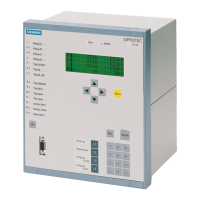2 Functions
108
7SD5 Manual
C53000-G1176-C169-1
2.4.2 Setting Notes
General The intertrip function for tripping caused by the differential protection can be activated
(YES) or deactivated (NO) with address 1301 I-TRIP SEND. Since the differential pro-
tection devices theoretically operate with the same measured values at all ends of the
protected object, a tripping in the event of an internal fault normally is also carried out
at all ends, regardless of the infeed conditions at the ends. In special cases, i.e. if fault
currents are to be expected near to the pickup threshold, it may occur that one or more
ends do not issue a tripping command due to inevitable device tolerances. For these
cases I-TRIP SEND = YES ensures the tripping at all ends of the protected object.
Intertrip/Remote
Tripping
If the intertrip function is activated, it will automatically start when the differential pro-
tection trips.
If the relevant binary inputs are allocated and activated by an external source, the in-
tertrip signal is transmitted as well. In this case, the signal to be transmitted can be
delayed with address 1303 T-ITRIP BI. This delay stabilizes the originating signal
against dynamic interferences which may possibly occur on the control cabling.
Address 1304 T-ITRIP PROL BI is used to extend a signal after it has been effec-
tively injected from an external source.
The reaction of a device when receiving an intertrip/remote tripping signal is set in
address 1302 I-TRIP RECEIVE. If it is supposed to cause tripping, set the value
Trip. If the received signal, however, is supposed to cause an alarm only, Alarm
only must be set even if this annunciation is to be further processed externally.
The setting times depend on the individual case of application. A delay is necessary if
the external control signal originates from a disturbed source and a restraint seems
appropriate. Of course, the control signal has to be longer than the delay for the signal
to be effective. If the signal is processed externally at the receiving end, a prolongation
time might become necessary for the transmitting end so that the reaction desired at
the receiving end can be executed reliably.
2.4.3 Settings
2.4.4 Information List
Addr. Parameter Setting Options Default Setting Comments
1301 I-TRIP SEND YES
NO
NO State of transmit. the intertrip
command
1302 I-TRIP RECEIVE Alarm only
Trip
Trip Reaction if intertrip command is
receiv.
1303 T-ITRIP BI 0.00 .. 30.00 sec 0.02 sec Delay for intertrip via binary input
1304 T-ITRIP PROL BI 0.00 .. 30.00 sec 0.00 sec Prolongation for intertrip via
bin.input
No. Information Type of In-
formation
Comments
3501 >Intertrip L1 SP I.Trip: >Intertrip L1 signal input
3502 >Intertrip L2 SP I.Trip: >Intertrip L2 signal input
www . ElectricalPartManuals . com
